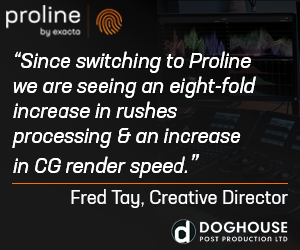Director of Photography/Lighting Cameraman Peter Moseley has more than 20 years experience shooting features, drama, commercials and factual programming. He has filmed over 100 commercials as well as BBC factual strands Horizon, Arena and Panorama.
He owns and operates a Sony F5 and a Canon C300, and was really interested in finding out more about Sony’s recent addition to its XAVC camera range, the FS5, which was first revealed at IBC2015.
With the camera now having had a few months to establish itself in the very crowded camera marketplace, Televisual arranged for Peter to get hold of an FS5 for three to four weeks in return for writing us a review. Here’s what Peter thought about the camera……..
Peter’s review of the Sony FS5
Created as part of a fairly extensive Sony family of 4K-capable cameras using the XAVC codec, the FS5 has a great deal to offer and is a camera that fulfils a number of uses. It’s light, flexible and easy to operate and is an ideal camera for ob docs and actuality.
It’s a handy camera for natural history and remote filming as it’s so small and easy to carry. It can also work as a second camera for its bigger brothers the FS7 or F5, where matching shot would not be that difficult. Stripped down, it is also useful as a camera for larger drones.
Appearance
In looks, it has a similarity to the Canon C300. In fact, the camera would fit seamlessly into rigs originally created for their C300. Like the C300, it has an easily detachable handle and monitor, however, on the FS5 these are much more robust and well designed.
I would guess the FS5 has been created to supersede the FS700. It has many of its features, including cached super slow motion, and a similar menu. But, having had time to get this camera right, and with the rapid advances in technology, the FS5 also incorporates some remarkable features such as face recognition, electronic variable ND and full auto capabilities. This makes it a camera that will create good pictures, virtually straight out of the bag.
Cards
The FS5 shoots to fast SDXC cards, which is a major advantage as they are fairly cheap, standard cards.
Codecs
The FS5 offers up to 4K recording. This is at present limited to the lower end 4:2:0 8-bit colour sampling XAVC L codec, partly due to using SDXC cards.
Having a play with the codec in Slog3, it does restrict what is possible in the grade. When trying to match cameras you can see discernable differences in quality. There have been issues with this codec and Avid and it’s something that will have to be resolved between the two companies.
The equivalent mLUT applied to the viewfinder also makes it difficult to see what you’re actually getting, and, with 4:2:0 8-bit exposure, this is much more critical. However, that being said, this camera does produce remarkable pictures. Additional codecs enable you to shoot from AVC to 4K, which makes the FS5 very flexible for filming everything from low budget corporates to broadcast documentaries.
Features
Electronic Variable ND
The FS5 has many features that are quite unique. It is one of the first cameras to have an electronic variable ND, which is particularly useful if you want to maintain depth of field rather than pulling stop. Using variable nds on the front has become the norm for filming with many large sensor cameras, which has not been ideal, restricting matte box use and issues of flare. It’s also handy when moving from different lighting conditions – going from inside to outside – and when using Canon glass with an adaptor you don’t get the problem of incremental clicking.
Centre Scan
The camera has the centre scan function in HD, which is assignable to any of the assign buttons and allows you to double your lens size, which can be very useful. It also means you are able to use 2/3 inch HD lenses and 16mm lenses, with the right adaptors. The caveat to this is it is important to make sure the lens is properly supported, as the E mount isn’t strong enough on such a small camera.
Assign Buttons and Handle
You can assign many functions to the assign buttons, which make it very simple to move between settings. On top of this, much of the functionality of the camera can be easily operated through the FS5 camera handle. The handle is well designed, allowing you to swivel and to shoot at different camera heights.
Picture Profiles
The camera has a number of picture profiles, including Slog2 and Slog3, as well as hypergammas and standard 709 settings. There are therefore plenty of options for getting a variety of looks and getting the most out of the camera’s 14 stops of dynamic range. The XAVC codec has proved to be a great improvement on the HD 422 Mpeg2 codec and so much more versatile for colourists and in the edit.
High Speed
The high speed capabilities of this camera are quite remarkable and the camera operates in a similar fashion to the FS700 with a picture cache memory buffering system up to 240fps in full HD to 960fps at a much lower resolution. The option is there to either record pre- or post- press of the record button. The length of slow mo shot varies depending on the resolution used but can also be set internally within a range. At 960fps the picture isn’t particularly useable but 400fps isn’t bad depending on what the pictures are used for.
Viewfinder and Monitor
The viewfinder and top monitor are a great improvement on the poor quality, Heath Robinson elastic banded FS700. The viewfinder works well with a clear picture and a swivel arm. The top monitor provides excellent pictures and, with a hood, is more than useable in daylight conditions. Both have switchable peaking, zebras and display. There is also the ability to add an external viewfinder, if wanted, such as a Zacuto.
Face Recognition
Face recognition is a very useful feature on the FS5 and is similar to that found on the A7S II camera, although in lowlight it does struggle and can be slow to react. With care, it works well.
Additional Features
The FS5 has two easy-to-connect audio XLR inputs. Sound can be controlled and monitored fairly simply. The auto functions on the camera are actually fairly good, with full, iris and focus buttons that respond if needed.
It operates reasonably well in lowlight although in no way competing with the A7S. For a little extra, it comes with the E mounted 18-105mm F4 zoom, which is light, covers the length needed and is a handy lens for simple jobs. Sticking to Sony-friendly lenses is probably a better choice, although it will take all the standard L series Canon zoom lenses with an EF adaptor.
Conclusion
The FS5 is a great little camera. For those run and gun shoots when you need to grab a camera in a hurry, where you don’t want to haul around a beast and a heavy tripod, it’s a fantastic choice.
For me this camera is better as a second camera than, say, an A7S or similar. Although these cameras are useful, particularly in low light, the FS5 has many advantages – it can be set up in no time, it has buttons where you need them and it is built for filming.
It has its flaws and, as an F5 owner, I wouldn’t use it on more complex commercial jobs where you need to shoot in proper 4K. However, it’s a well-designed, welcome addition to Sony’s long list of cameras.
Staff Reporter
Share this story


















